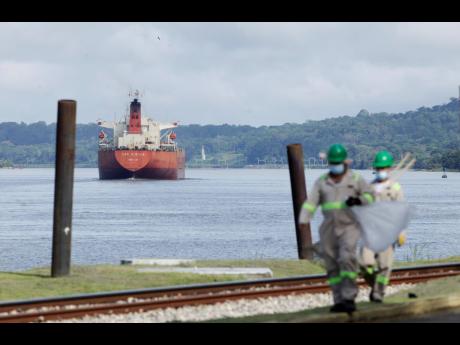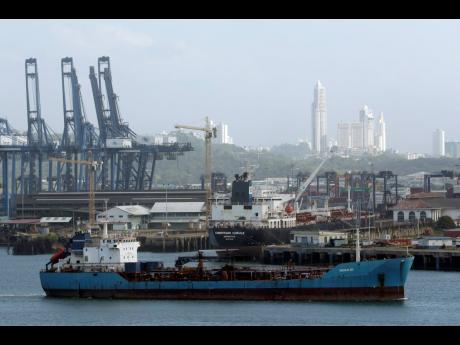Ainsley Brown | Drought affecting Panama Canal set to have ripple effects on Jamaica
Imagine a natural disaster that can potentially drive up the cost of food, energy, and retail items while negatively impacting manufacturing, tourism, exports, bank interest rates and even inflation, and basically impacting the whole of the Jamaican economy, from pocketbook economics to macroeconomics. Yet, this natural disaster, which is actually happening, has yet to garner the level of attention it deserves.
No, I am not talking about another pandemic, a hurricane or an earthquake. I am talking about the drought in Panama and its effects on the Panama Canal. And, yes, I must confess there has been some coverage which has mainly focused on the occurrence of the drought and the restrictions imposed by the Panama Canal Authority (ACP). However, less attention has been focused on the potential impacts on Jamaica and the wider region’s economy.
With an estimated five to six per cent of global trade passing through it annually, the Panama Canal is a major thoroughfare for international trade. Operational for over 100 years, this artificial waterway that links the Atlantic and Pacific Oceans connects approximately 2,000 ports in 170 countries, according to the ACP. The Panama Canal operates 24/7, 365 days a year, with 13,000-14,000 ships transiting annually.
The Panama Canal is a key conduit for the transportation of various commodities, with the main points of origin and destination being the USA, China and Japan, the top-ranking economies globally by GDP. The canal enables the movement of items essential for industry and everyday life, including raw materials such as ores and metals; energy-based products such as petroleum, liquefied natural gas (LNG), propane cooking gas; retail items such as clothes, toys, electronics; food such as grains, fruits, vegetables; canned foods, edible fats and oils, etc.
Needless to say, anything impacting the canal impacts the world.
CRITICAL ACCESS
For Jamaica and the region, the Panama Canal represents a critical access point that facilitates connectivity and the flow of goods and services. The impact of the Panama Canal goes far beyond shipping, and highlights the complexity of modern supply networks, which are more interlinked than ever. This interconnection helps to explain why the Russia-Ukraine war triggered price increases and, with it, inflation in food, namely flour and edible fats and oils in Jamaica and many other countries that do not necessarily import those items from either of those countries. However, Russia and Ukraine are major exporters of these items, and any negative impacts on supply will naturally have ripple effects globally.
At the risk of oversimplification, but increasing the surety of understanding, I will illustrate with a few examples. Incidentally, these examples serve a dual purpose of highlighting Jamaica’s logistics hub and why I have said elsewhere that Jamaica is a logistics hub; it just doesn’t know it yet.
For Jamaica, the canal broadly impacts three things, which are themselves interconnected. First, it creates a marketplace for Jamaica to tap into. Second, it helps to drive Jamaica’s exports, and third, it impacts local consumer prices.
The Panama Canal, though it does not do so exclusively, creates a marketplace for the centralisation of various economic activities facilitated by, among other things, Jamaica’s geographic location. Ships moving from the Atlantic to the Pacific or vice versa may stop off in Jamaica to do one or more of several commercial activities. These may include dropping off containers destined for a third location, i.e. trans-shipment; imports being taken in for either domestic consumption or as inputs into production; for refuelling, i.e. bunkering; the changing of ships’ crews; reprovisioning of ships’ supplies, i.e. chandlering; repairing of ships either while on the water or lifted out of the water in our new floating dry dock, etc.
The canal improves Jamaica’s export competitiveness by reducing sailing time to market, specifically for Jamaican exports destined for the US West Coast, the Far East (e.g. China) or the West Coast of South America. The same is also true in the reverse, lowering costs of inputs into production coming from those same markets.
The importance of the Panama Canal to Jamaica, the region, and the world is without question, and the fact that it is experiencing the effects of the global climate crisis is cause for concern to us all.
STATE OF EMERGENCY
High temperatures and drought conditions led Panama to declare an environmental state of emergency in May, which prompted the ACP to impose draught restrictions on ships, reducing the amount of cargo a ship could carry. The problem is a lack of water needed to operate the canal’s locks mechanisms. These locks require massive amounts of water, approximately 52 million gallons or enough to fill almost 76 Olympic-size swimming pools per ship per trip.
This is not the first time the Panama Canal has imposed depth restrictions. However, this move was unusual because the restrictions were put in place during the rainy season, which runs from May to December. Panama is experiencing the worst drought since records have been kept. It has forced the ACP to impose even further restrictions at the end of July, cutting the daily crossings to 32, down from the usual 34 to 36. The restrictions continue with the latest, at the start of November, with the number of crossings reduced to 25 and progressively going to as low as 18 in February 2024.
These restrictions mean that not only are there fewer ships traversing the canal, but the ones that do are doing so lighter and, according to some reports, up to 40 per cent lighter, leading some shipping lines to impose a surcharge to compensate for the loss of business, which inevitably will be passed on to consumers.
It has even led to significant delays of up to 21 days, use of alternate routes to bypass the canal, and even led one company to pay a record US$3.975 million to avoid the queue rather than wait 21 days.
Although the implications of these restrictions have yet to be fully felt by Jamaican consumers, retailers, or manufacturers, it is only a matter of time. Part of the reason we have not felt it yet is that much of, though not all,the cargo, which comes to and from Jamaica that passes through the canal is containerised. Container ships tend to book their transits well in advance and have experienced insignificant delays. However, this situation in Panama will inevitably have an inflationary effect on food prices, edible oils and fats, energy and other commodities. It may also mean less commercial activity in Jamaica. However, it also represents an opportunity to attract nearshoring manufacturing and warehousing as a resilient counter to what is taking place in Panama.
Ainsley Brown is adjunct lecturer in logistics and supply chain management at the Mona School of Business and Management and UWI Five Islands Campus. Send feedback to brown.ainsleyc@gmail.com.



